Events
There are two event types to choose from: Message-Only & Action-Based. Both events require an Event ID and Endpoint to be selected. Additionally, the UI allows attributes from each data source to be selected which is forwarded to the chosen endpoint. For all events, we suggest selecting customer first/last name, email ID, phone number, and all relevant channel information (push note, email and text message) with their preference flags from the customer profile with customer ID (custID) and transaction date time (sysDateTime) from real-time attributes.
The checkbox "Mark all events as a non-marketing event message" disables our default global contact policy check. This default is currently set to limit the outgoing events to 50,000 in 1 day, per customer, across all events. There is also an event level contact policy that can be configured in the Details tab.

Global event settings
In order to better understand each event option, we will explore different use-cases as we have done above.
Message-Only Events
Message-Only events are used when an event needs to be sent out each time audience & trigger conditions are met. This is the default selection in the Events tab. Inputs to be provided are shown in the image below. Mandatory fields are marked with an asterix in the UI, without which the user cannot progress.
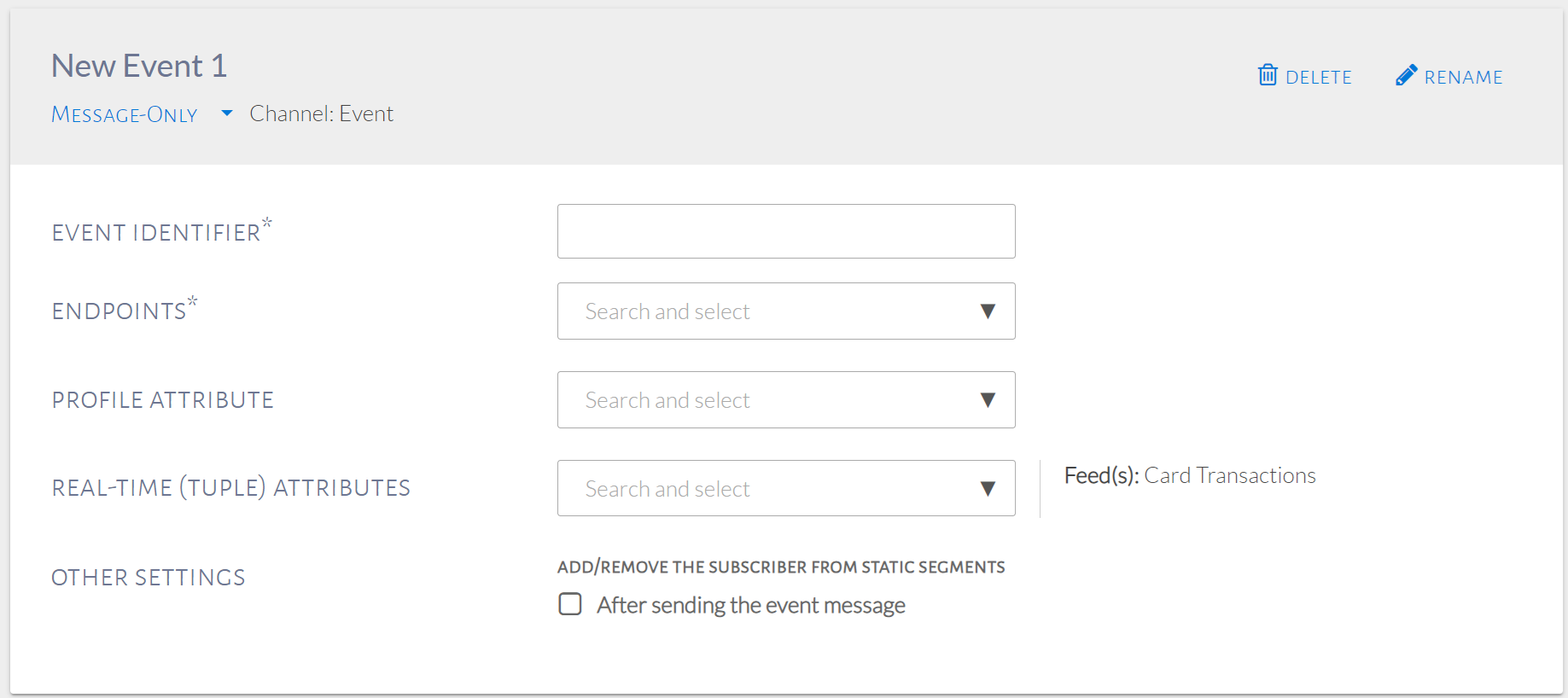
Message-only event
Event Identifier & Endpoints selection is mandatory. The image below contains a sample event ID. It is important that this ID matches with the one expected by the endpoint systems (Application or DB) so that stitching together events with offers is seamless. Endpoints should be selected
based on if the event is real-time (Application) or batch (DB). Both can be selected as shown in the image below.
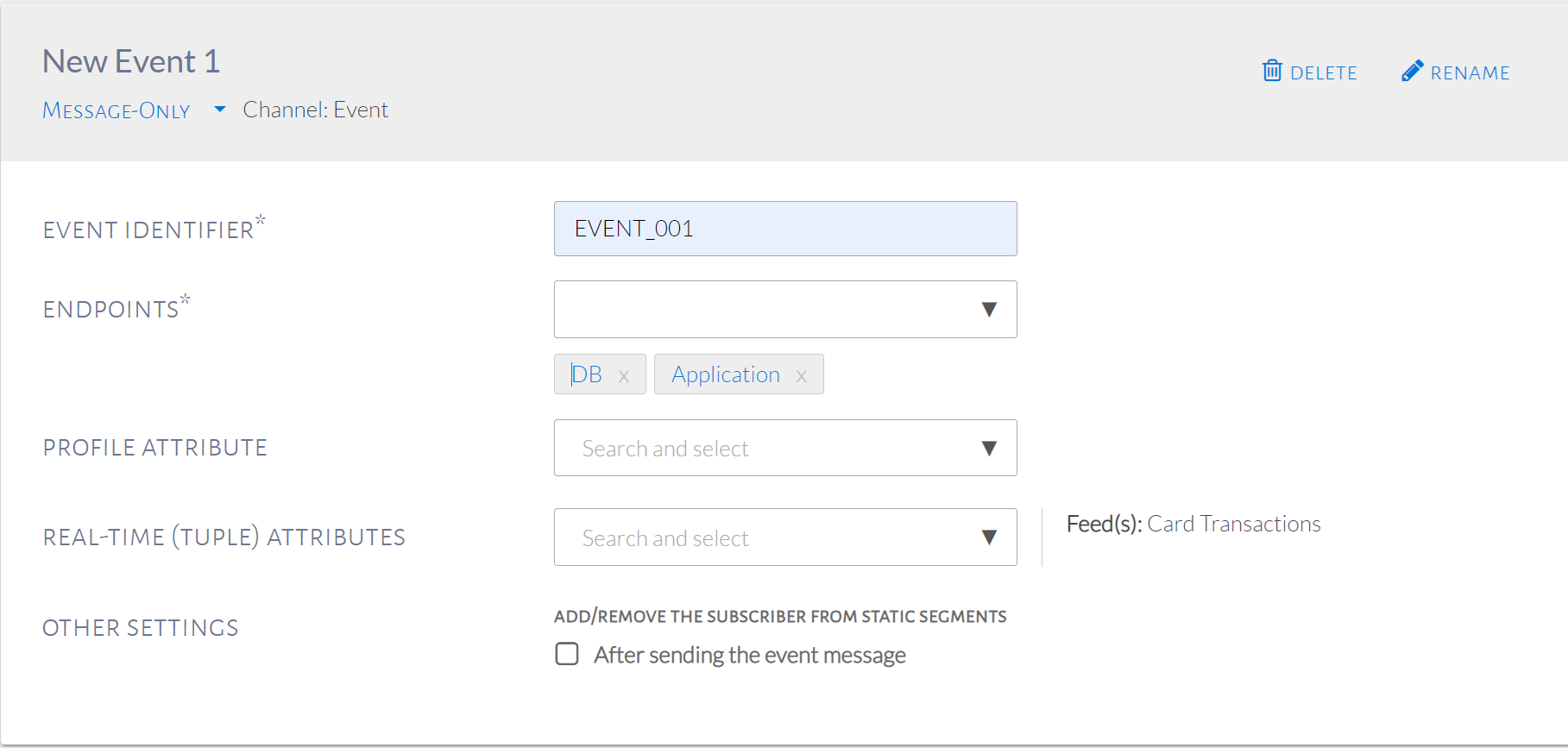
Event ID & endpoints selected
The Profile & Real-time Attributes dropdowns provide all attributes being ingested by either data source to be selected by the user. Multiple attributes can be selected based on what is expected by the downstream systems. For the real-time source, the Feed(s) with attributes present for selection are displayed on the right. Currently, we are only ingesting Credit Card Transactions in real-time.
The image below shows how attributes can be searched for and selected. Continuing our previous use case, with trigger conditions identifying usage of Freshers card for international transactions, we can choose to forward transactionAmount.
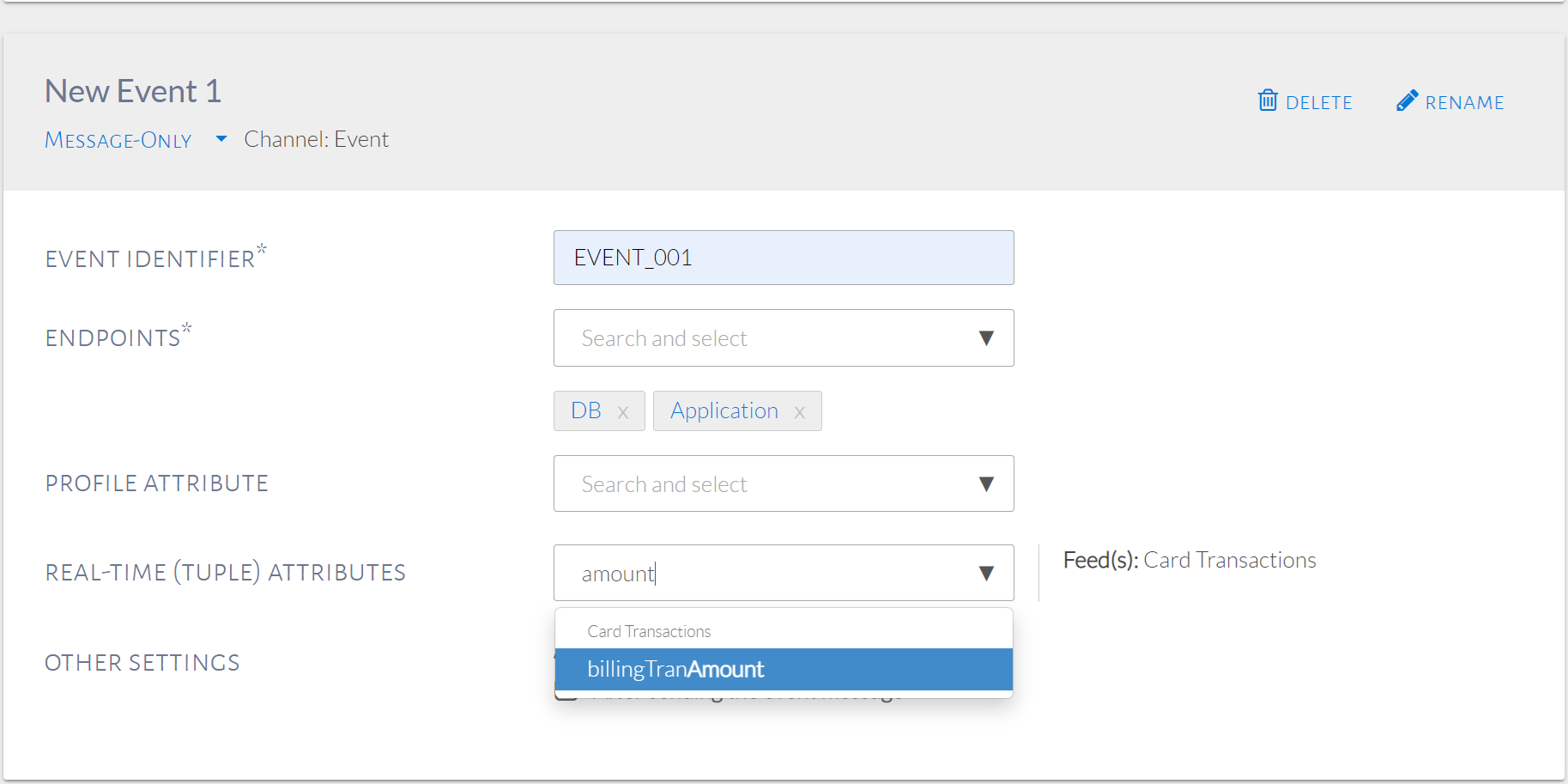
Real-time attribute search
Similarly, we can choose to forward profile attributes as well, for offer personalization. Final attributes selected are shown in the image below.

Final event selection
Action-Based Events
For Action-Based Events, the customer must complete an action to receive the product of an event. Time-based & Milestone-based reminders can be added as well.
Summary of Steps:
- From the Events page, select Action-based and fill up general event information.
- Select Event Action.
- Fill in the Action details.
- Set Time-Based Reminders and/or Milestone Reminders.
- Fill in the Fulfillment Event information.
Select Action-Based as shown in the image below and add in the information as seen in below.
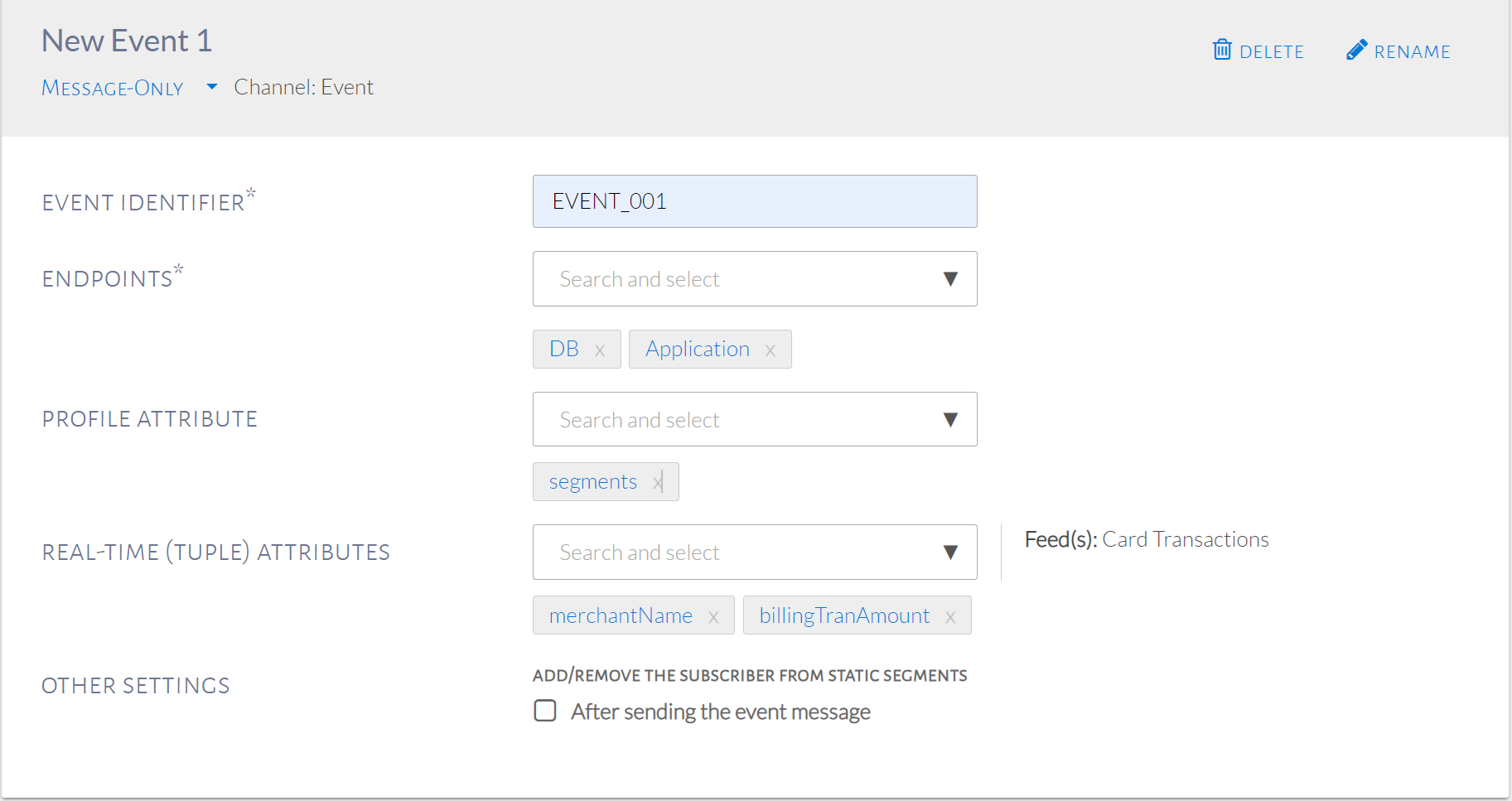
Action-based event
Next, select the desired event action, as seen in the image below. Among the customers qualified for the event, this filter will monitor which customers performed a specified action. For this example, select Cumulative Transaction as we want to monitor the total spend amount in a given time period.
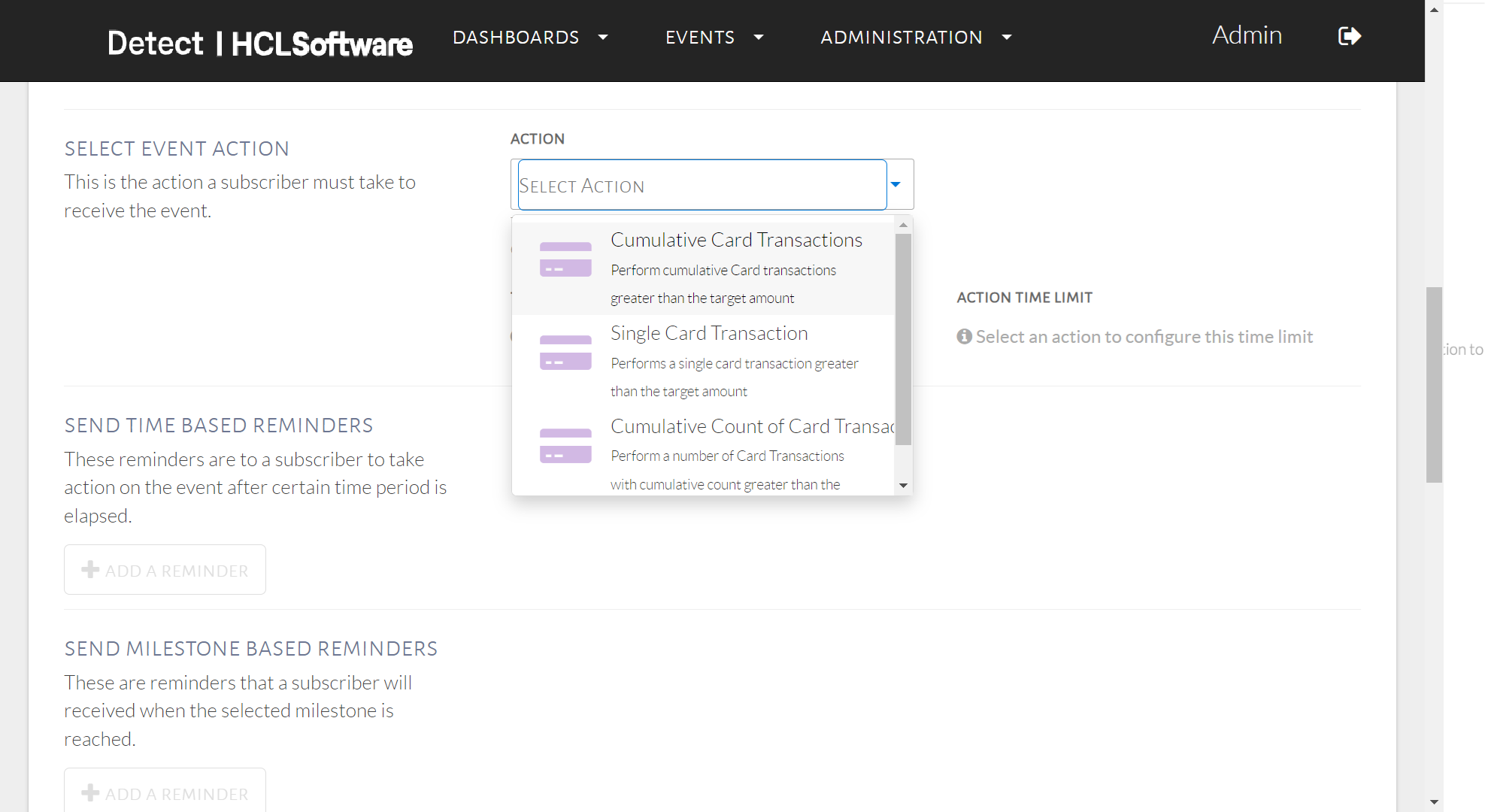
Event action options
The Single Transaction option will monitor the transaction amount but for a single transaction only, in a given period of time. Cumulative Count of Transactions monitor the number of transactions in a given time period. Do note that for the Cumulative Count option, the threshold does not take into consideration the message that has been sent out the first time a customer fulfills the trigger and audience conditions.
For all selected actions, filters can be added to all of these options as well. Add in the target amount of $15,000 and time limit of 7 days as per our example use case. This is shown in the image below.

Cumulative transactions
Filters can be implemented as shown in the image below. These are in addition to the audience and trigger configurations and can be modified similarly.
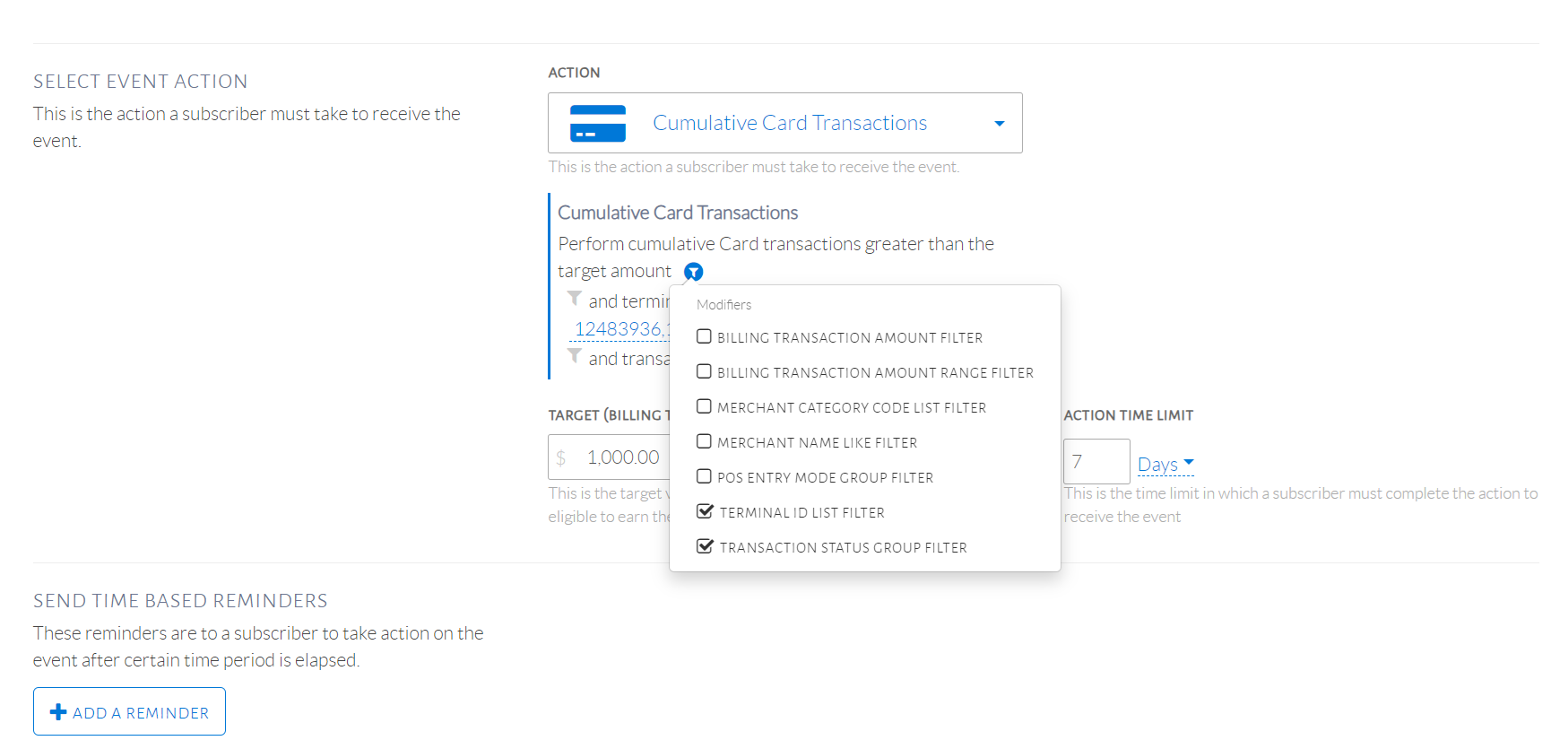
Cumulative transaction filters
Final filter selection shown in the image below. As a result of this setup, the downstream systems will receive a message once the amount and time period conditions are met. The message received is defined in Fulfillment Message, mentioned below after reminders.
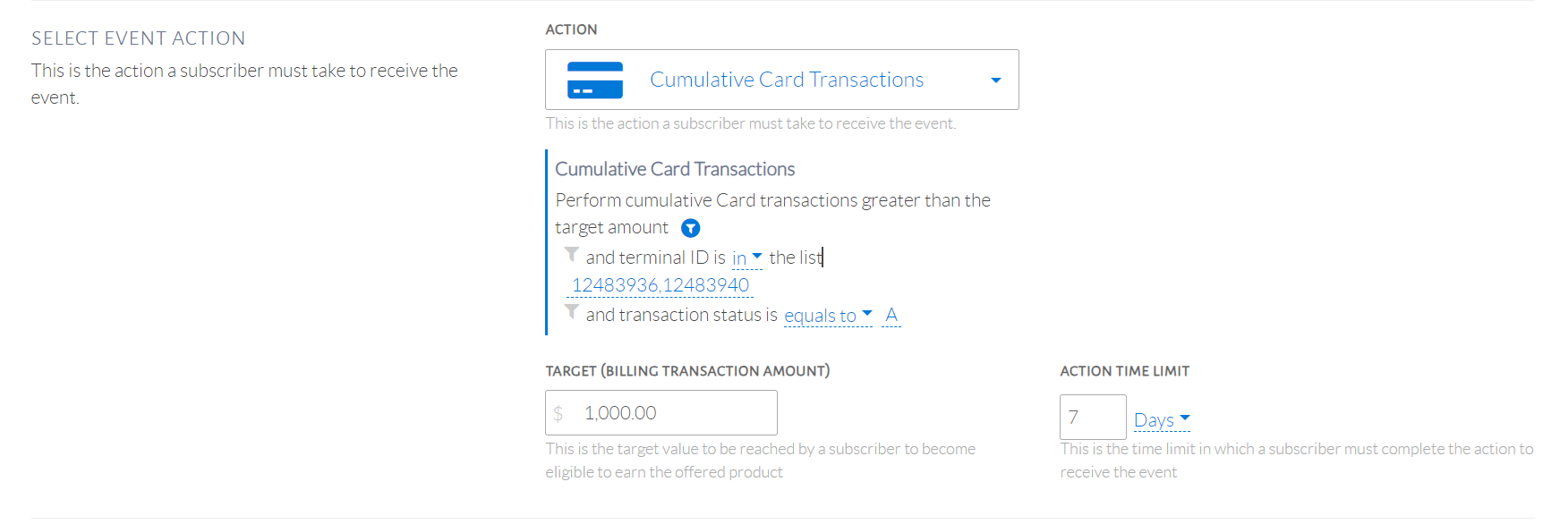
Final filter selection
Reminders can also be set by clicking Add a Reminder. Time-Based Reminders send a message to the customer based on the amount of time that has passed, which can be specified. Milestone-based Reminders send a message to the customer based on the purchase amount the customer has reached, which can be specified. These can be seen in the image below. For Cumulative Transactions, both reminders are possible and so are available for selection.

Reminders in an event
Upon clicking Add a Reminder to both options, the same options as a message-only event appear with a time and amount threshold for time and milestone based reminders respectively. The image below shows these fields. Once those thresholds are reached, another event is triggered by the system and forwarded to the selected downstream systems. Multiple time and milestone based reminders can be set as required.
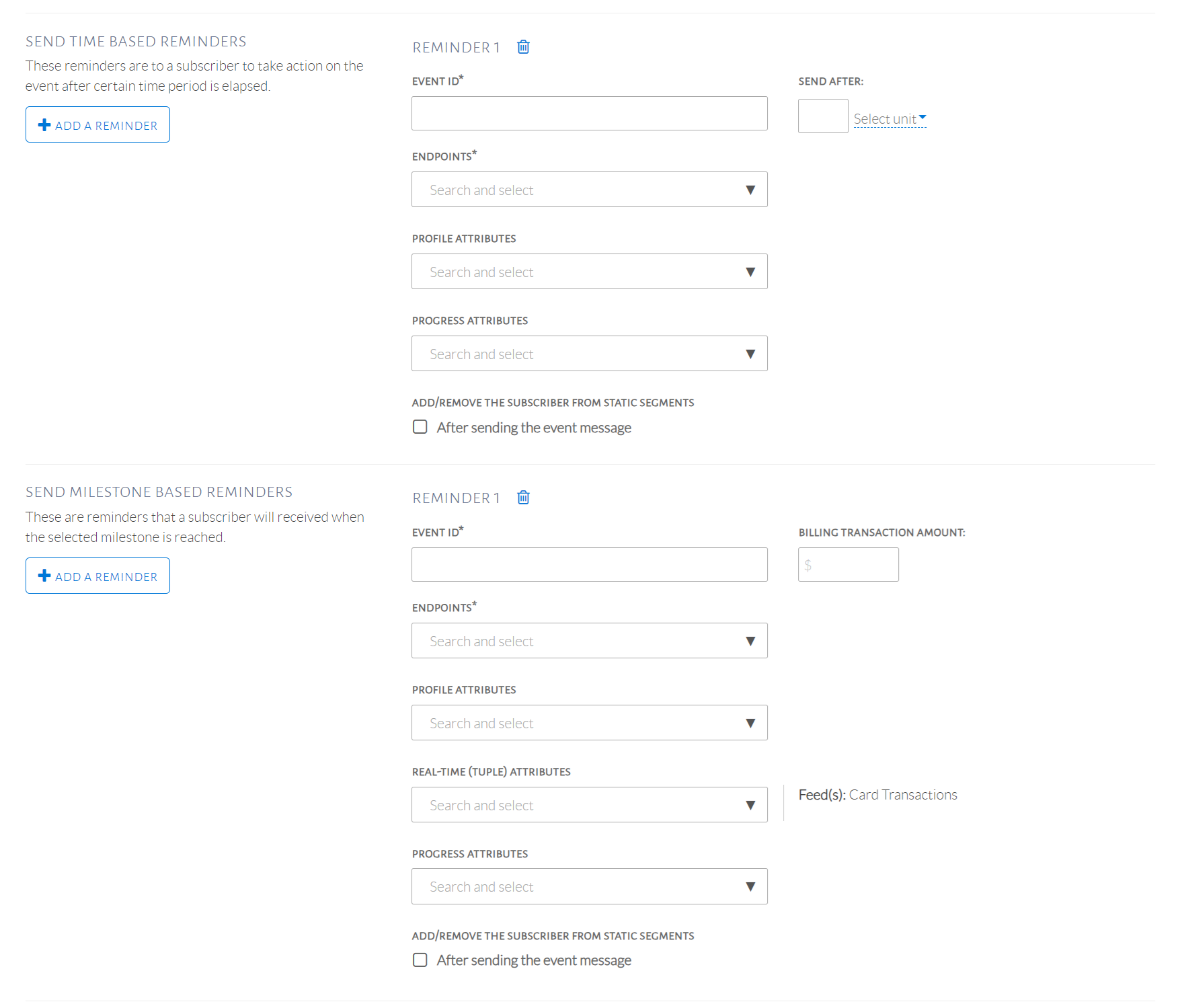
Time and milestone based reminders
In the image above, there is also an option to forward Progress Attributes to the selected downstream systems. These 4 attributes represent the count or amount progress of the customer. They are Current Value, Remaining Value, Target Deadline and Total Value. Current Value represents the completed transaction count/amount. Remaining Value represents the transaction count/amount that is left for the action to be completed which is to meet the threshold in Selected Event Action. Target Deadline represents when the time threshold, configured in Selected Event Action will end. Total Value represents the target count/amount to be achieved in order to complete the action.
The Fulfillment Message defines what will be sent to the downstream system once the Event Action criteria is fulfilled. Selections here can be same or different than the initial event message and following reminders as shown in the image below.

Fulfillment message
Target Groups
Target groups can be used to assign events to different groups among the customers who have qualified for the event.
USE-CASE: Assign the event "Nike Women" to all females who qualify, "Nike Men" to all males who qualify, and "Nike Others" to everyone else who qualifies
Summary of Steps:
- Create multiple events by clicking Add New Event.
- Choose conditions for each target group, making sure a customer cannot be part of multiple groups.
- Assign an event to each target group.
- Set an Everyone Else target group.
The events can be set-up as shown in the 3 images below. Edit the name of an event by clicking Rename.
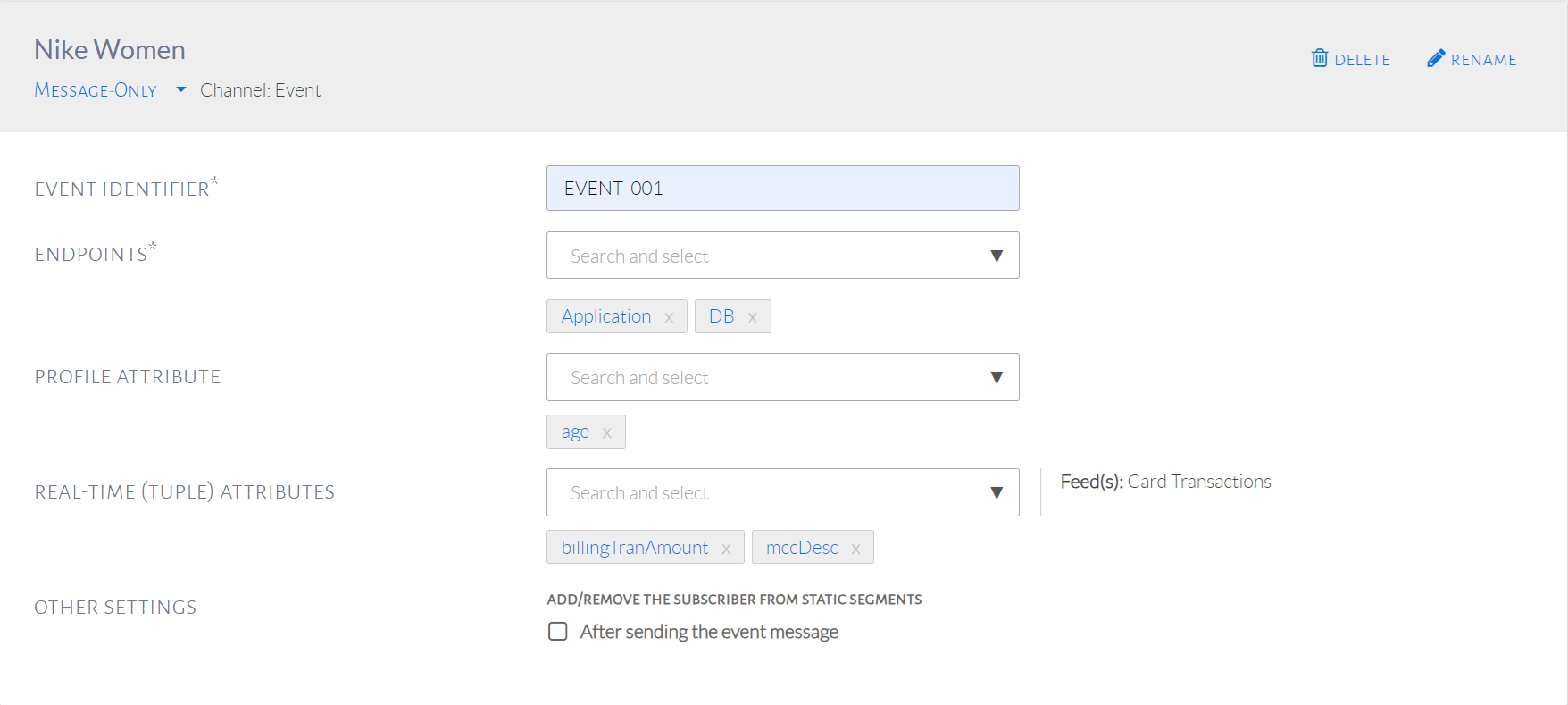
First event
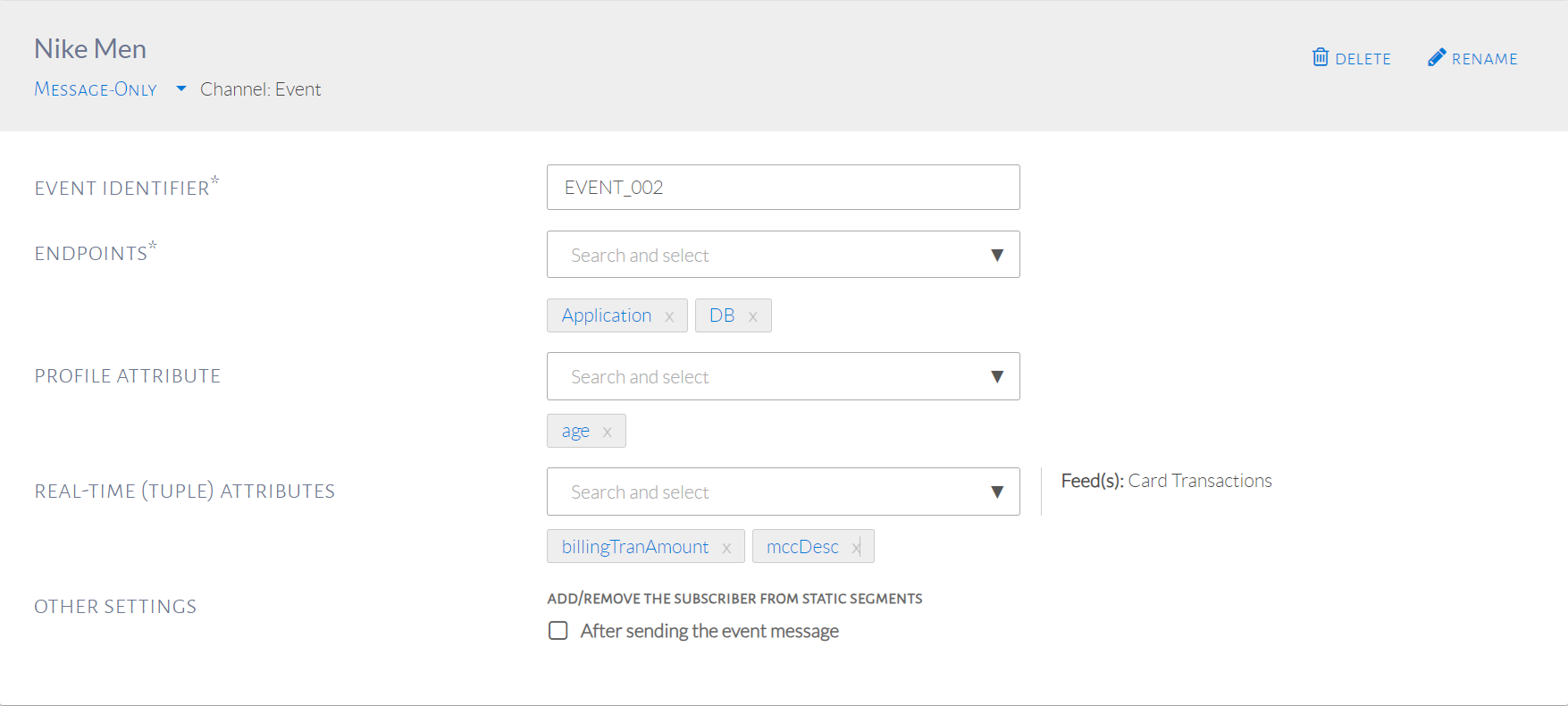
Second event

Third event
Assign an event to a specific target group as seen in the image below. Click on the orange icon near the event dropdown, to choose the conditions for each target group.

Assigning an event to a target group
The popup for audience conditions will be shown, as seen in the image below. Select the desired conditions for the target group. For this example, we will select the condition Customer's Gender which is in demographic conditions.
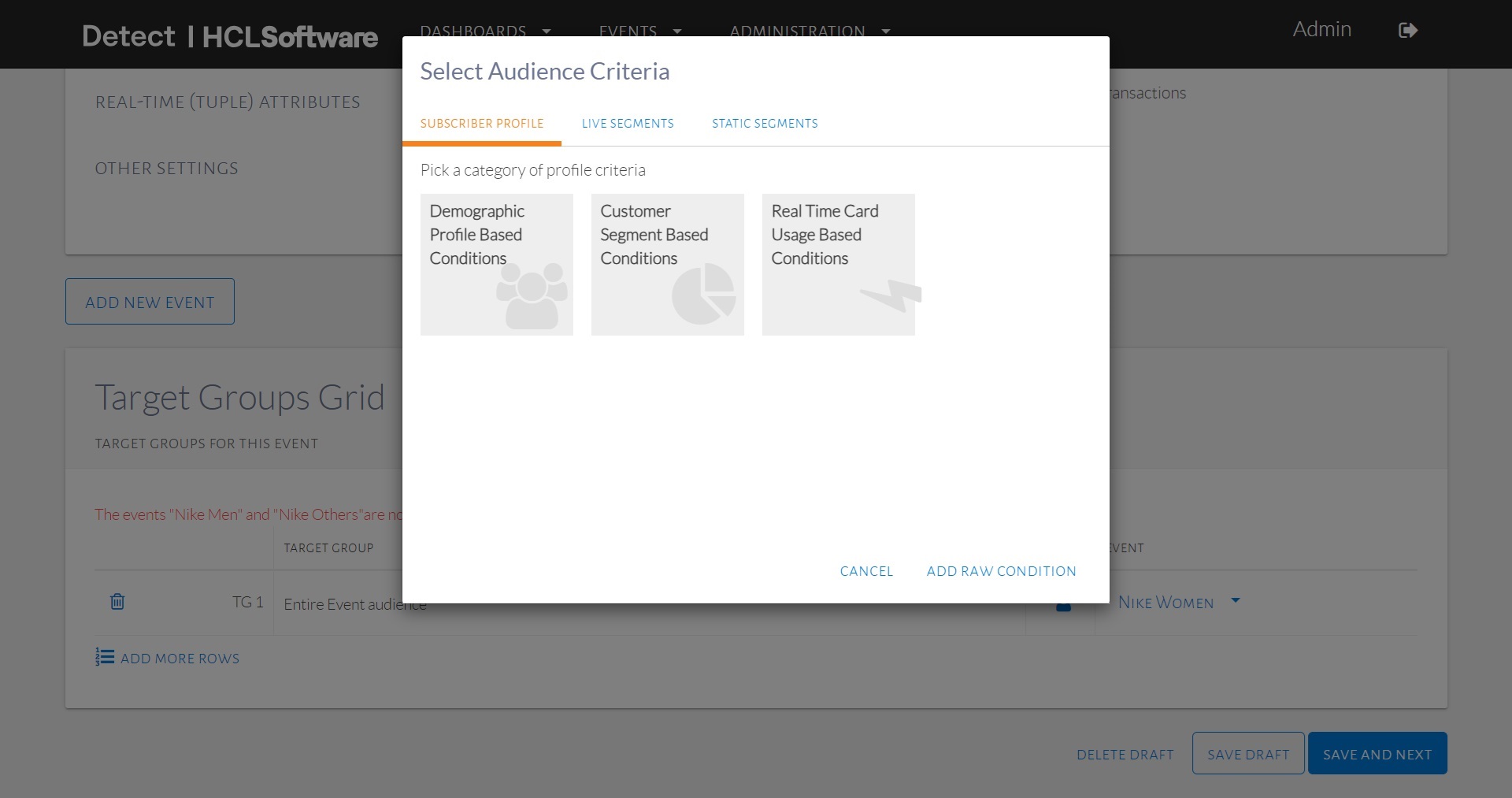
Selecting conditions for the target group
The condition for the target group is shown in the image below, along with the event assigned.

Target Group 1 comprises the females who qualify for the event.
The final set of target groups can be seen in the image below. It is important to note that an Everyone else target group must be set. Target groups must also never intersect, that is, a customer should not be part of 2 target groups. If this happens, only the event of the first target group will be received.
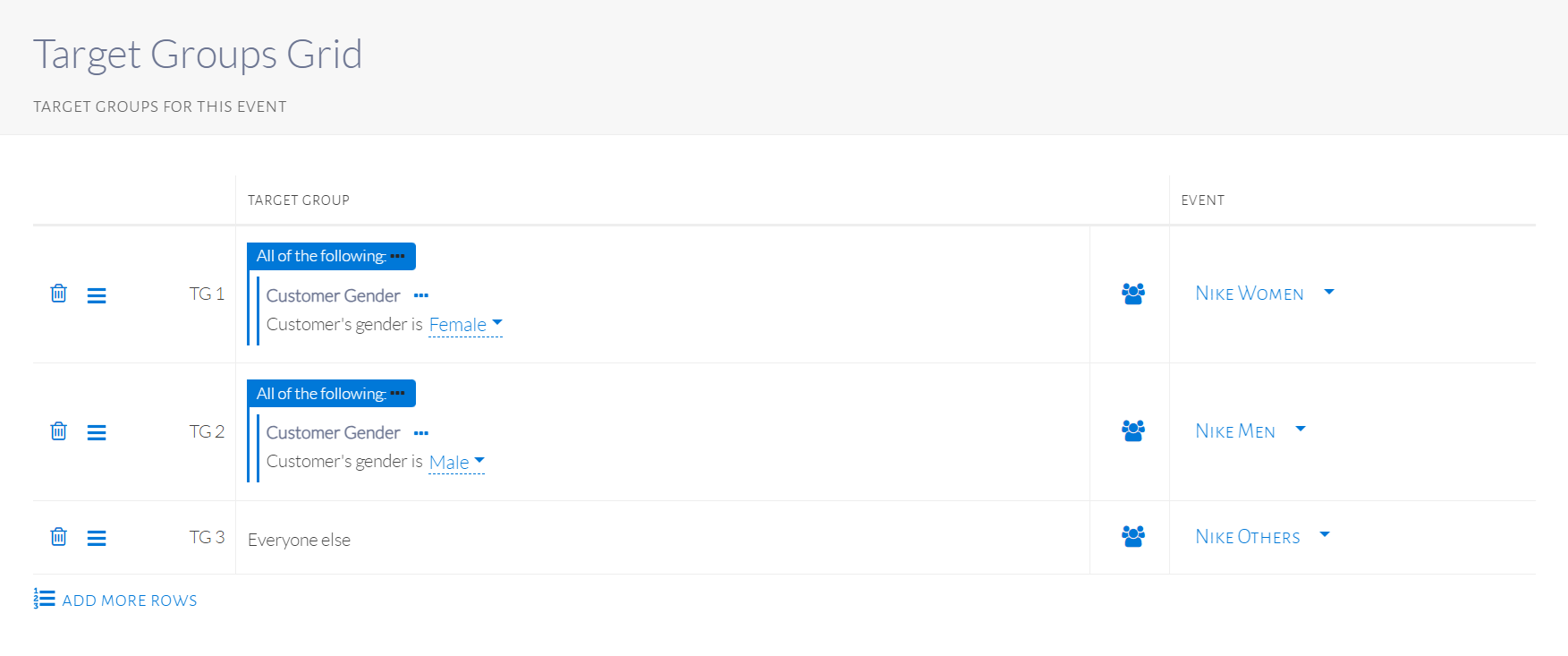
Final set up of target groups